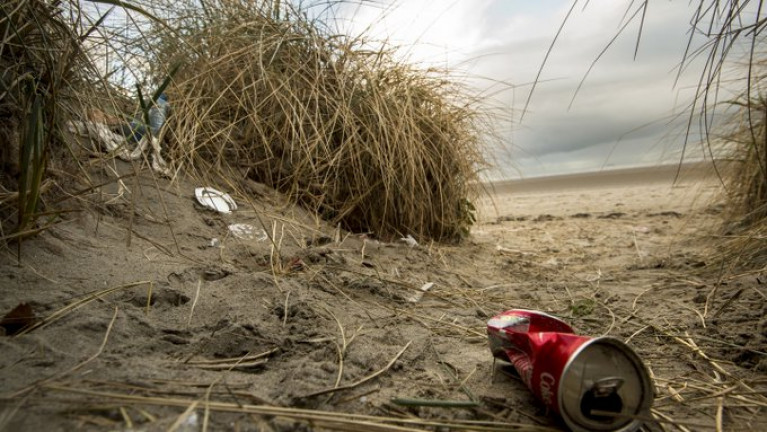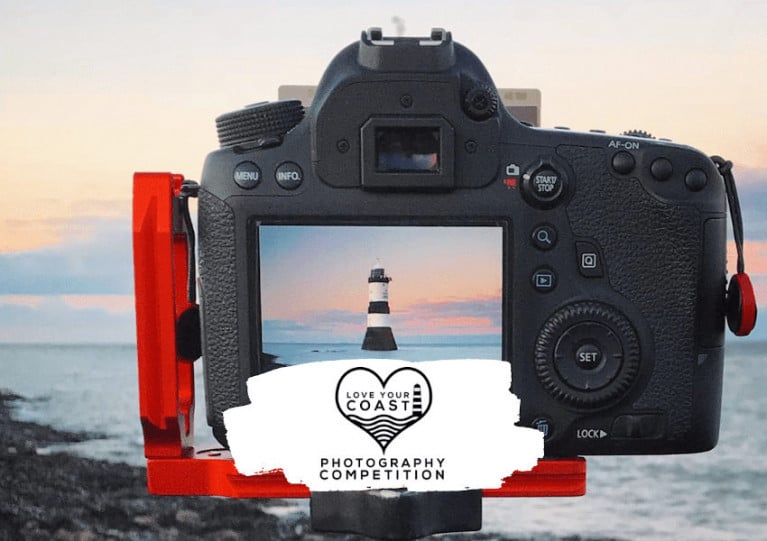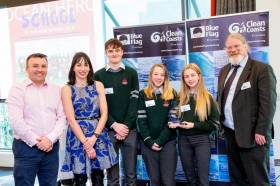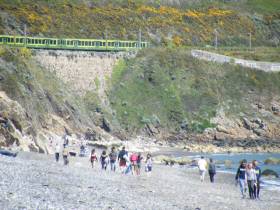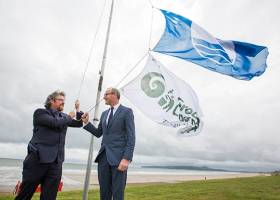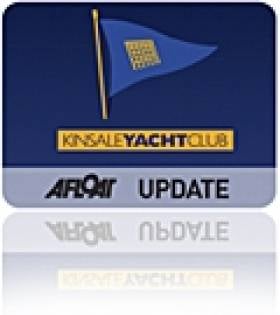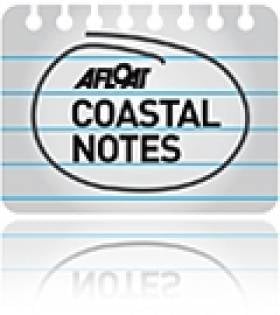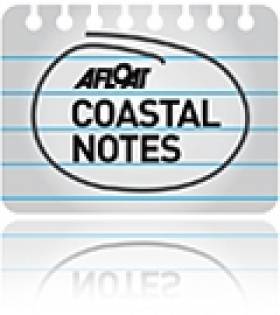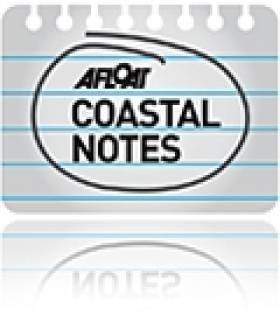Displaying items by tag: An Taisce
Fewer than half of the beaches and harbours in the State have been deemed clean, but the situation is getting better, according to an annual survey published by Irish Business Against Litter (IBAL).
Cork Harbour at Blackrock Castle and White Bay in Co. Cork were “heavily littered” and among the worst areas surveyed, while Salthill suffers from “overflowing litter bins” and dumped coffee cups, fast-food litter and sweet wrappers, clothing and plastics.
Beaches, harbours, rivers and their immediate environs were monitored by the Environmental Education Unit of An Taisce in June and July on behalf of IBAL, which last led a survey two years ago.
The beaches declare dclean were Brittas Bay, Curracloe, Lahinch, Clogherhead, Portmarnock and Strandhill, though Bundoran, Keel in Mayo and Dog’s Bay in Galway join Salthill on the littered list.
The seafront in Bray was praised by the inspectors, as was Kilmore Quay in Wexford and Dún Laoghaire, but Kinsale, Bantry and Castletownbere harbours in Co. Cork failed to make the grade.
In all, just 40 per cent of 32 coastal areas surveyed were deemed clean to “European norms”, but this is an improvement on the survey results two years ago when just 16 per cent passed the European test.
Further reading from The Irish Times.
Ten Days to Close of Marine Protected Areas Consultation - An Taisce Clean Coasts Hosts Workshop
With just ten days to go in the public consultation on marine protected areas, An Taisce’s Clean Coasts programme is reminding people to “have their say”.
Ireland currently protects just over two per cent of territorial waters, and the Government has committed to expand this to ten per cent “ as soon as is practical”.
The Government aims to have 30 per cent of waters designated as marine protected areas (MPAs) by 2030.
A public consultation on MPAs initiated by Minister for Housing Darragh O’Brien and Minister of State for Heritage Malcolm Noonan closes on Friday, July 31st at 5 pm.
Clean Coasts is hosting a workshop this Thursday, July 22nd to address any issues arising from the public consultation.
It says that scientific research shows that MPAs – as in areas of the ocean where certain activities are not allowed or strictly regulated - are one of the most beneficial tools to safeguarding the ocean, protecting biodiversity and increasing fish stocks.
Noonan has added his voice this week to the Clean Coasts appeal for public participation,
“We’re still fortunate in Ireland to have a productive, awe-inspiring and beautiful marine environment. But that environment is under increasing threat,” he has said.
“You have a vital role to play in shaping its future. I’m asking you to act now and have your say in how we protect our seas and ocean - in the short term and in the long term,” he has said.
Clean Coasts is a charity programme, run through An Taisce’s environmental education unit, and engages communities in the protection of Ireland’s beaches, seas and marine life.
Currently, there are over 1400 registered Clean Coasts volunteering groups, which participate in. hundreds of beach clean-ups and remove considerable quantities of marine litter from shorelines and waterways.
Book a spot for the Clean Coasts workshop here
The MPA public consultation is here
Winners Selected in 2020’s ‘Love Your Coast’ Marine Photography Awards
The winners have been chosen in 2020’s Love Your Coast marine photography competition.
As the Irish Examiner reports, this year’s awards ceremony went virtual on Facebook Live, with the winning entries across four categories sharing in a €5,000 prize fund.
More than 40 images were shortlisted across the categories of Coastal Landscape, Wildlife & The Coast, People & The Coast and Coastal Heritage.
And the big winner was Ivan Donoghue, whose photos of divers — and specifically one encountering a jellyfish — earned him the overall award.
See the complete gallery of images on the Love You Coast website HERE.
Clean Coasts Honours Ireland’s Ocean Heroes Of 2018
St Colman’s Community College in Midleton, Co Cork was named School of the Year in the recent Ocean Hero Awards presented by the Clean Coasts programme at the Clayton Hotel Cork City recently.
This year Clean Coasts’ Ocean Hero Awards celebrated 11 years of honouring the invaluable contribution Ireland’s coastal communities have made towards conserving our spectacular coastline.
The awards, originally known as the Merit Awards, were conceived in 2006, consisting then of only one category, The Clean Coasts’ Group of the Year.
Since then the Clean Coasts programme has grown to engage over 700 groups, becoming embedded in many coastal communities nationwide.
In an effort to recognise this growth, the number of Ocean Hero categories have also expanded to include Individual of the Year (won this year by Sean Ferguson), Beach Clean of the Year (won by Havin’ a Laugh), Business of the Year (Dive Academy, Wexford) and the Think Before You Flush campaign award (Galway Atlantaquaria_ as well as the original Group of the Year award (Keep Our Beaches Clean, Mayo).
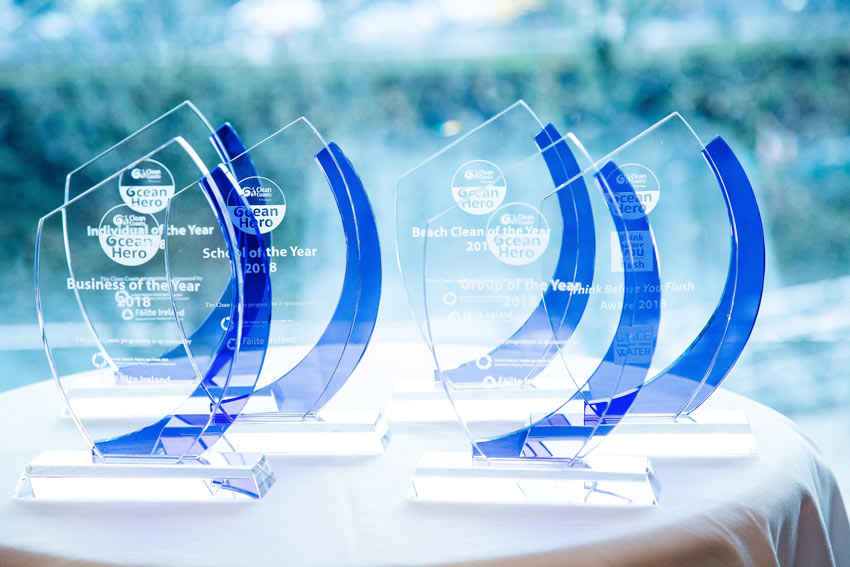
The presence of marine litter in our oceans is a global concern that requires action. Adequate measures are needed to address the impacts of litter in the marine environment
both at sea and on land whereby public awareness and community action plays a vital role.
The Clean Coasts Ocean Hero Awards and Ocean Talks bring together key stakeholders in the area of marine litter such as coastal communities, NGOs, tourism bodies, the science community, business and the fishing industry.
Ocean Talks speakers included Minister of State Damien English; Ken O’Sullivan, creator of RTÉ’s Ireland's Deep Atlantic; Sinead McCoy, coastal communities manager with the Environmental Education Unit at An Taisce; and Annabel Fitzgerald of Irish Water.
McCoy said: “Over the past 12 years the Clean Coasts programme’s Ocean Hero Awards have really brought to the fore the remarkable work and wonderful coastal celebration events that Clean Coasts volunteers have been involved in along the Irish coastline.
“We hope next year is no different as we look forward to receiving inspirational nominations that show the true dedication of these coastal custodians.”
Clean Coasts is operated by the Environmental Education Unit of An Taisce and is funded by the Department of Housing, Planning, and Local Government and Fáilte Ireland.
#CoastalNotes - Blue flags have reached a record total in those awarded to Irish beaches and marinas for 2018 by An Taisce environmental group.
The 83 Irish beaches and seven marinas writes The Irish Times, that have achieved the accolade must adhere to specific criteria related to water quality, information provision, environmental education, safety and site management – and comply with bathing water regulations considerably above minimum EU standards.
The number of sites receiving the blue flag is up two on last year’s total.
Carne in Co Wexford has achieved Blue Flag Status for the first time ever this year, while Ardmore in Co Waterford has been awarded for the flag first time since 1997 following the completion of a new wastewater treatment plant in the area during 2016.
All beaches and marinas awarded in 2017 retained blue flag status for 2018. Killiney and Donabate beaches in Co Dublin lost their blue flags in 2017 and did not regain them in 2018 due to their current bathing water classification by the EPA. See related story, on Dublin and Galway beaches that failed to meet EU minimum standards.
For a map giving location and a list of awarded Blue Flag status beaches click here in addition for more on the story.
An Taisce Blue Flag & Green Coast Awards
An Taisce announced the International Blue Flag Award and the National Green Coast Award recipients for the 2016 bathing season. A total of 141 awards were presented by the Minister for the Environment, Community and Local Government, Mr. Simon Coveney, T.D, at an awards ceremony held on the Velvet Strand, Portmarnock in Fingal at 12 noon today.
Speaking at the awards Minister Coveney noted that “In Ireland, we are particularly fortunate to have a varied and beautiful coastline with many pristine beaches that are open to the public to enjoy. However, we cannot rest on our laurels and must continue to make strident efforts to protect and improve our waters. This will ensure that we, and future generations, can continue to enjoy this wonderful resource.”
Mr. Ian Diamond, Coastal Awards Manager at An Taisce’s Environmental Education Unit speaking at the awards said:
“I would like on behalf of An Taisce to pay tribute to the Local Authorities and marina operators here today for all their efforts in ensuring that the sites being awarded for the 2016 bathing season have achieved the excellent standards required by the Blue Flag and Green Coast Awards”.
The 79 Irish beaches and 6 marinas are awarded the prestigious Blue Flag Award for the 2016 bathing Season.
The Blue Flag is one of the world’s most recognised eco-labels. The programme aims to raise environmental awareness and promote sound environmental practices and behaviours among beach and marina users. The 79 Irish beaches and 6 marinas that achieved this accolade met a specific set of criteria related to water quality, information provision, environmental education, safety and beach management.
As a pre-requisite, the bathing water at Blue Flag beaches must meet the highest standards of bathing water quality. The overall Blue Flags in Ireland this year is down only one on 2015, whilst four of the beaches awarded in 2015 did not retain Blue Flag status, the Blue Flag will be raised for the first time at Ballymoney North Beach in Wexford and Brittas Bay North regains Blue Flag status lost last year. Fenit Marina in Kerry has also been awarded a Blue Flag this year whilst all of the marinas awarded last year have retained Blue Flag status for the coming season.
An Taisce – The National Trust for Ireland is responsible for the operation of the Blue Flag programme in Ireland on behalf of the Foundation of Environmental Education.
Blue Flag Applications were not received for the following beaches that had been in receipt of the award in 2015: Redbarn (Cork), Garretstown (Cork), and Portrane (Fingal). These beaches did not meet the excellent water quality standard required for Blue Flag status. Ross Strand in Mayo was not awarded the Blue Flag due to there being less lifeguard cover than advised during in-season control visits.
56 Beaches receive the Green Coast Award for the 2016 Bathing Season
The Green Coast Awards were presented back in 2003 to four beaches in County Wexford. Since then, the award has gone from strength to strength recognising beaches for their clean environment, excellent water quality and natural beauty. An important aspect of the Green Coast Awards is the involvement of Clean Coasts groups of which there are now 499 comprised of thousands of volunteers throughout the island. These volunteers participate in community clean-ups and coastal enhancement projects at their local beaches throughout the year.
56 beaches in Ireland were awarded the Green Coast Award representing a decrease in 3 awards since 2015. Boatstrand in Waterford is being awarded for the Green Coast Award for the first time since 2010, whilst Red Strand in Cork has regained the award due in part to improved water quality.
Having not met the excellent water quality standard required, Rocky Bay in Cork, Portrane in Fingal, Mayo’s White Strand and Cross in Louisburgh did not retain the award for the 2016 bathing season.
Kinsale Yacht Club has won a blue flag for its coastal marina for the first time in today's An Taisce announcement of the International Blue Flag Awards for 2015.
A total of 144 awards were presented by the Minister for the Environment, Community and Local Government, Mr. Alan Kelly, T.D, at an awards ceremony held on Ballinskelligs Beach in Kerry. Ireland's diverse coastline with long sandy beaches, bustling promenades and rocky shores have something for everyone.
Kinsale Yacht Club marina is located in a natural, virtually land-locked harbour on the estuary of the Bandon River, approximately 12 miles south west of Cork harbour entrance. It is home to a thriving fishing fleet as well as frequented by commercial shipping, it boats two fully serviced marinas, with the Kinsale Yacht Club & Marina being the closest to the town.Visitors to this marina automatically become temporary members of the club and are therefore entitled to make full use of the facilities.
Speaking at the awards ceremony Minister Kelly said, "Blue Flags represent excellence. They are a clear signal of quality and are something to be cherished. I am delighted to announce that today we will be awarding a total of 86 Blue Flags; 81 for beaches and five for marinas. A blue flag flying at a particular location means that it has achieved excellent water quality to standards set by European and national Regulations, and a very high grade across a wide range of other criteria"
He added that, "This is testament to the sterling efforts of local authorities, An Taisce and of local communities in ensuring that their beaches meet the standards of excellence required for a Blue Flag or Green Coast Award',
81 beaches and 5 marinas were awarded the prestigious Blue Flag award representing an increase in 6 Blue Flag awards since 2014.
Ms Annabel FitzGerald, Coastal Programmes Manager said that, "The Blue Flag is an award of excellence, the beaches and marinas that have achieved this accolade today have complied with strict criteria relating to water quality, safety, facilities for visitors, beach management, environmental education and the provision of information."
In Cork, Redbarn and Garretstown have regained the Blue Flag status and in Wexford, Ballinesker is being awarded the Blue Flag for the first time. 5 beaches that failed to comply with the requirements of Blue Flag in 2014 because of storm damage have regained their Blue Flag status, they are Bertra and Mulranny in Mayo, Rossbeigh in Kerry and Miltown Malbay and Spanish Point in Clare.
Brittas Bay North in Wicklow, Enniscrone in Sligo and Skerries in Fingal have lost their Blue Flags due to failure to comply with water quality requirements for the Blue Flag.
58 beaches in Ireland were awarded the Green Coast Award representing an increase in 4 awards since 2014. Bishopsquarter and Seafield in Clare and Inchydoney East in Cork are being awarded for the Green Coast Award for the first time. In Wexford, Ballyhealy, Ballymoney, Booley Bay, Grange and St Helens Bay have also achieved the accolade.
Having not met the excellent standard required, Skerries in Fingal, Rathmullan in Donegal, Enniscrone in Sligo and Ballycastle in Mayo did not regain the Green Coast Award for 2015.
"The Green Coast Award recognises beaches for their clean environment, excellent water quality and natural beauty. These beaches may not have the necessary built infrastructure required to meet the criteria set for Blue Flag status however they are exceptional places to visit and enjoy our rich coastal heritage and diversity."
An important aspect of the Green Coast Awards is the involvement of Clean Coasts groups of which there are now 440 comprised of thousands of volunteers throughout the island. Ms FitzGerald, paid tribute to these groups stating that, "Clean Coasts groups contribute significantly to the protection of Irelands coast, in 2014 over 800 beach cleans took place and these groups removed over 500,000 items of marine litter from the marine environment."
"Local Authorities, Marina Operators and local communities should be commended for their efforts in achieving Blue Flag and Green Coast award status today" Ms FitzGerald concluded.
SUMMARY OF AWARDS
o 144 awards presented today, an increase of 10 on last year's number.
o 86 Blue Flags are being awarded today in the Republic of Ireland, 81 to beaches and 5 to marinas.
o This is an increase of 6 Blue Flags since 2014, representing an increase of 5 Blue Flag beaches and 1 Blue Flag marina.
o 58 Green Coast Awards are being presented today representing an increase of 4 Green Coast Awards since 2014.
o 6 beaches will be presented with both the Blue Flag & Green Coast Award achieving dual award status. These are Portmarnock, Portrane and Donabate in Fingal County Council; Salthill and Silver Strand in Galway and Rosses Point in Sligo.
BLUE FLAGS GAINED
Beaches (+8)
o Wexford: A Blue Flag is being awarded to Ballinesker for the first time.
o Cork: 2 Blue Flags were regained in Redbarn and Garretstown.
o Kerry: A Blue Flag was regained in Rossbeigh.
o Clare: 2 Blue Flags were regained in Miltown Malbay and Spanish Point.
o Mayo: 2 Blue Flags were regained in Mulranny and Bertra.
Marinas (+1)
o Kinsale Yacht Club has been awarded the Blue Flag for the first time.
BLUE FLAGS NOT AWARDED
Beaches (-3)
Blue Flag applications were received for the following beaches but we were unable to award the Blue Flag.
o Wicklow: Brittas Bay North did not comply with water quality requirements for the Blue Flag.
o Sligo: Enniscrone did not comply with water quality requirements for the Blue Flag.
Blue Flag applications were not received for the following beaches which did have the Blue Flag in 2014.
o Fingal: Skerries South Beach did not meet the excellent standard required for Blue Flag status.
GREEN COAST AWARDS GAINED (+9)
o Clare: Bishops Quarter and Seafield are being awarded the Green Coast Award for the first time.
o Wexford: Ballyhealy, Ballymoney, Booley Bay, Grange and St Helen's Bay are being awarded the Green Coast Award.
o Fingal: The Burrow is being awarded the Green Coast Award for the first time.
o Cork: Inchydoney East is being awarded the Green Coast Award for the first time.
GREEN COAST AWARDS NOT AWARDED (-5)
o Donegal: Rathmullan failed to comply with the water quality standards required for the Green Coast Award.
o Sligo: Enniscrone failed to comply with the water quality standards required for the Green Coast Award.
Green Coast Award applications were not received for the following beaches which did have the Green Coast Award in 2014.
o Mayo: Ballycastle in Mayo did not comply with water quality standards for the Green Coast Award.
o Fingal: Skerries did not comply with water quality standards for the Green Coast Award.
o Wexford: Ballinesker did not apply for the Green Coast Award but is in receipt of the Blue Flag in 2015.
Coastal Local Authorities to Attend Annual Blue Flag & Green Coast Awards Conference
#blueflags – An Taisce – The National Trust for Ireland and Green Coast Awards Conference isin Dublin, on 5th February. This conference will be attended by coastal Local Authority representatives as well as Blue Flag and Green Coast Award Jury members. It is expected that the devastating impact of recent storms will be discussed at the event.
Speaking about the upcoming conference Annabel FitzGerald, Coastal Programmes Manager, An Taisce said, "There are some serious concerns for some candidate Blue Flag and Green Coast Award beaches that have been left devastated by the recent storms particularly where infrastructure such as access roads, carparks and other amenities have been destroyed." These are among the 32 imperative criteria required to achieve Blue Flag status.
She added, "Local Authorities work tirelessly during the bathing season to ensure high standards at Ireland's awarded beaches but there is also a considerable amount of work required in advance of the bathing season as Local Authorities must adhere to strict award application procedures."
Speakers including Annabel FitzGerald (Coastal Programmes Manager, An Taisce), Bat Masterson (UCD, Blue Flag Juror), Peter Webster (EPA, Blue Flag Juror) will address delegates and lead discussions on issues relating to the Blue Flag and Green Coast Awards ahead of the 2014 bathing season. Crucial award criteria such as water quality, beach infrastructure, lifeguarding and marine litter will be discussed in detail.
Candidate Blue Flag and Green Coast Award applications are currently being prepared to present at the National and International Jury meetings. It is based on the recommendations of these jury meetings that Blue Flags and Green Coast Awards for 2014 will be awarded. It is anticipated that some Blue Flag and Green Coast applications may have to be withdrawn from the process because of the impact of recent storms the full extent of which is not yet known.
Dalkey Prospect Foreshore Licence Disputed
#DALKEY OIL LICENCE – An Taisce has alleged the Government acted unlawfully in how it granted Providence Resources a foreshore licence at the Dalkey Island prospect in Dublin Bay, reports The Irish Times.
In High Court proceedings, An Taisce claims the Government wrongly concluded an environmental impact assessment (EIA) was not required to be carried out prior to awarding the licence to Irish-listed oil and gas exploration company.
An Taisce claims that under the relevant EU directive an EIA is required and the decision of September 27th last granting the licence should be quashed. It is also seeking a declaration the Government has failed to properly transpose or implement environmental impact assessment Directive 2011 92 EU into Irish law.
The licence is for an area in the Kish Bank basin and allows Providence carry out a number of activities, including a seismic study, well site survey and the drilling of an exploration well. The edge of the licence area is about 10km from Dalkey Island.
Mr Justice Michael Peart yesterday granted the ex parte application (one side only represented) for leave to bring the judicial review proceedings and returned the matter to February.
As reported earlier this month on Afloat.ie, the Minister for Heritage Jimmy Deenihan announced proposals for six Special Areas of Conservation (SACs) sites to include an area designated between Rockabill to Dalkey Island.
Clean Coasts Week Is Underway
Thousands of coastal custodians around Ireland will be participating in the Clean Coasts Week (11-18th) which runs until next Friday.
The theme for the event is "Love Our Coast" which is to empower communities to participate in protecting and celebrating their local coastal environment along the spectacular coastline of Ireland.
The week forms part of An Taisce's Clean Coast Programme which is to emphasise the important role that we can all play, and are playing, in conserving our marine environment.
A list of the headline events in this third Clean Coast Week sponsored by Coca Cola can be viewed by visiting www.cleancoastsweek.ie


























